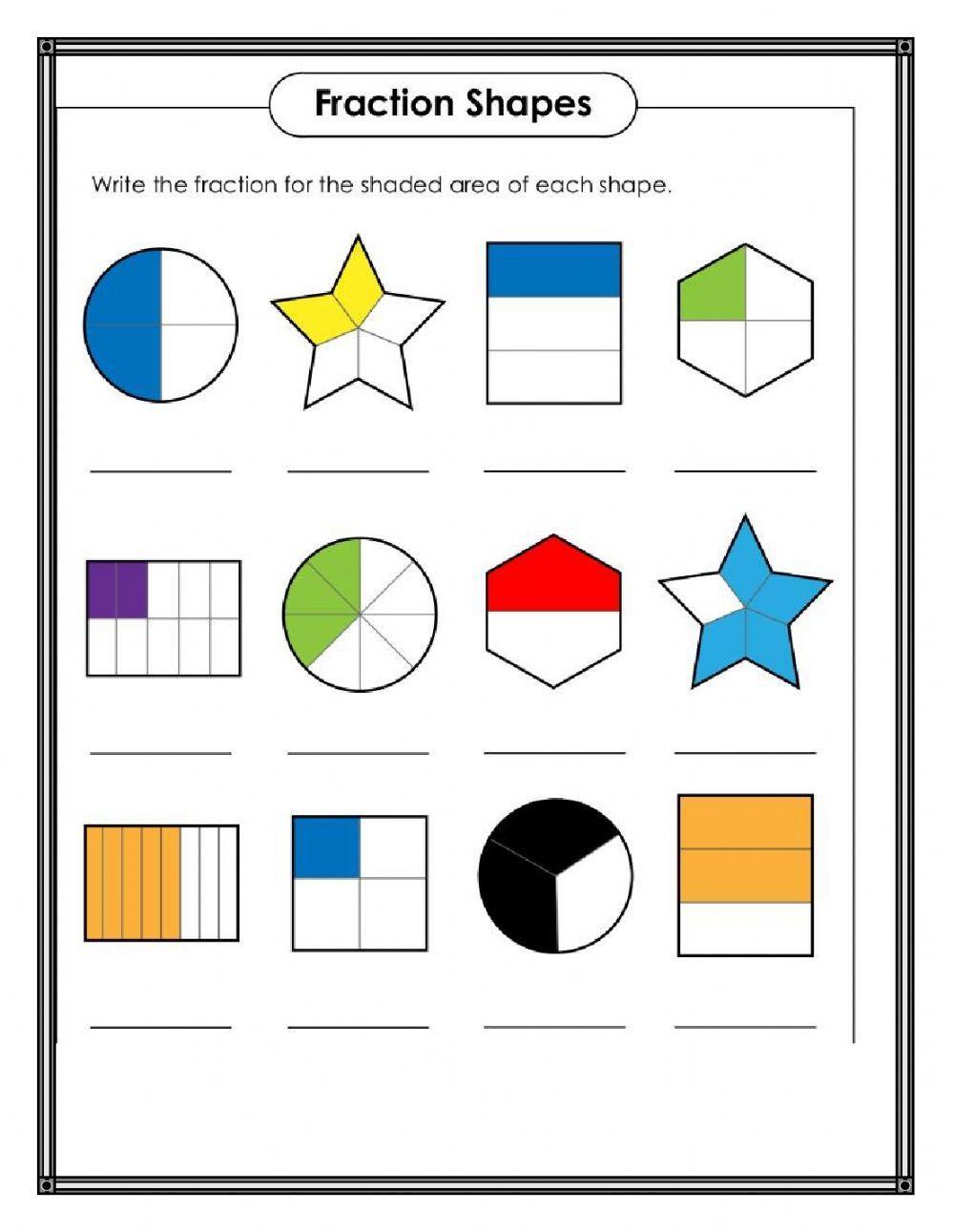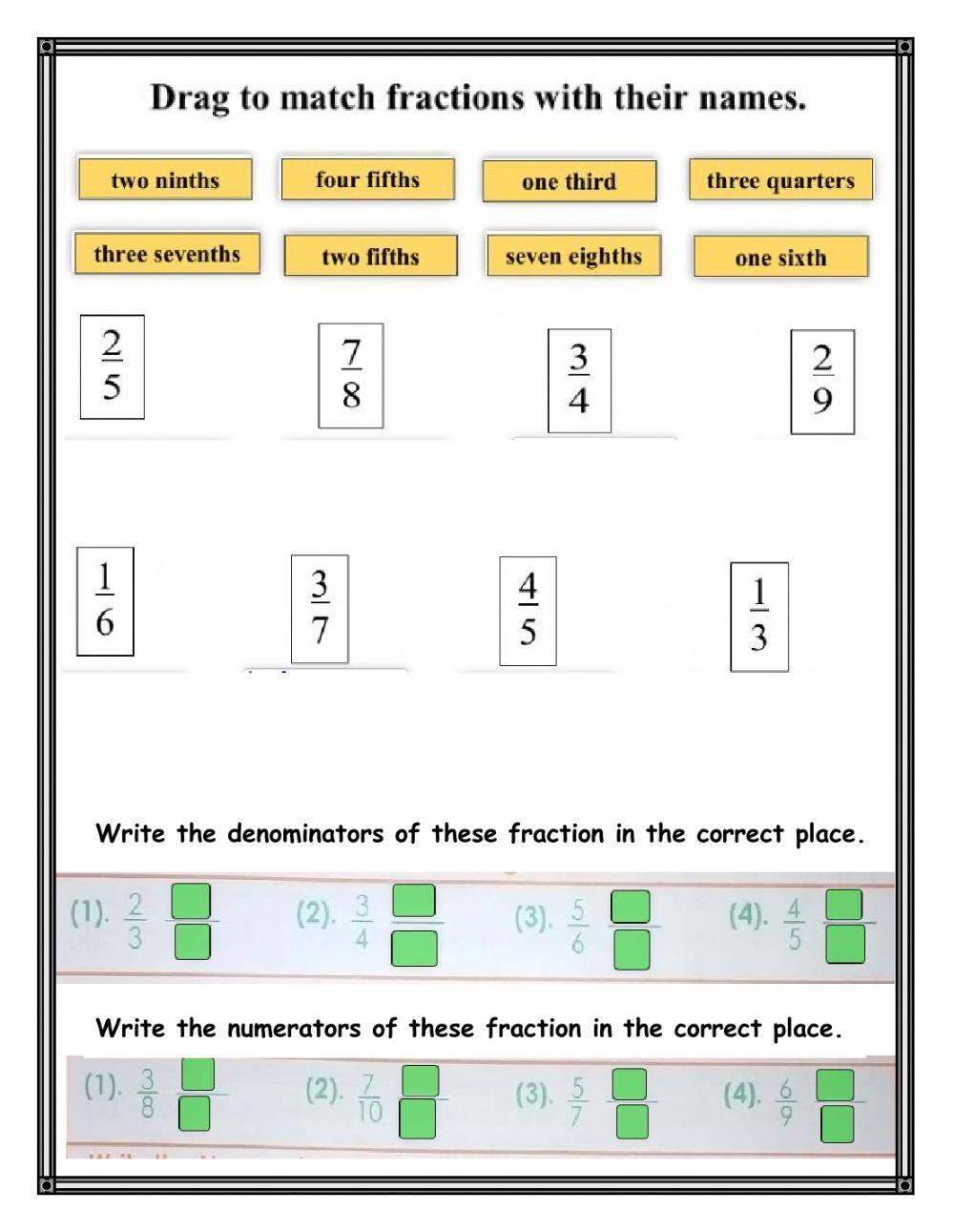Member for
4 years 5 monthsAge: 7-12
Level: Grade 3
Language: English
(en)
ID: 640904
18/01/2021
Country code: JM
Country: Jamaica
Main content: Fractions (2013150)
From worksheet author:
Identifying fractions as part of a whole. Identifying the numerator and denominator of a fraction
Other contents:
Identifying the numerator and denominator of a fraction.
Worksheet description:
Objective Explanation:
The objective of this worksheet is to enable students to enhance their understanding and proficiency in working with fractions. By engaging with visual representations of fractions through shaded shapes, students will develop the ability to identify and write fractions accurately, translating visual information into numerical form. This exercise aims to strengthen students' foundational knowledge of fractions and their application in mathematical operations.
Content Overview:
This worksheet delves into the concept of fractions, focusing on representing fractions through visual manipulatives such as shapes. Students will be tasked with determining the fraction of the shaded area in each shape, allowing them to practice identifying and writing fractions based on visual cues. Key skills addressed include recognizing parts of a whole, understanding numerator and denominator relationships, and interpreting fractions in a real-world context. By mastering these fundamental concepts, students will build a solid foundation for more complex fraction calculations in the future.
Language and Educational Level Context:
Tailored for students at an introductory level in math, this worksheet is presented in English to cater to students with proficiency in the language. The instructions are concise and straightforward, ensuring that students can easily comprehend and follow along with the task at hand. The visual nature of the exercise provides support for students who may be visual learners or have varying levels of language proficiency, allowing them to grasp the concept of fractions through hands-on practice.
Subject Relevance:
Aligned with the Math curriculum, this worksheet seamlessly integrates into the broader scope of mathematical education. Fractions are a fundamental aspect of mathematical reasoning and problem-solving, playing a crucial role in various mathematical operations and real-world applications. By mastering the concept of fractions, students can enhance their mathematical fluency and reasoning skills, laying a solid groundwork for future mathematical learning and problem-solving tasks in more advanced math courses.
Instructions:
Drawing from the instructions to "Fraction Shapes - Write the fraction for the shaded area of each shape," the worksheet is structured around a series of shapes divided into different sections, with specific areas shaded for students to identify. For each shape, students are required to determine the fraction represented by the shaded portion, expressing it in fractional form with the numerator and denominator. This direct task guides students through the process of translating visual information into mathematical notation, reinforcing their understanding of fractions and their representation. By applying this instruction to each shape, students can practice writing fractions accurately and gain confidence in working with fractional concepts.
The objective of this worksheet is to enable students to enhance their understanding and proficiency in working with fractions. By engaging with visual representations of fractions through shaded shapes, students will develop the ability to identify and write fractions accurately, translating visual information into numerical form. This exercise aims to strengthen students' foundational knowledge of fractions and their application in mathematical operations.
Content Overview:
This worksheet delves into the concept of fractions, focusing on representing fractions through visual manipulatives such as shapes. Students will be tasked with determining the fraction of the shaded area in each shape, allowing them to practice identifying and writing fractions based on visual cues. Key skills addressed include recognizing parts of a whole, understanding numerator and denominator relationships, and interpreting fractions in a real-world context. By mastering these fundamental concepts, students will build a solid foundation for more complex fraction calculations in the future.
Language and Educational Level Context:
Tailored for students at an introductory level in math, this worksheet is presented in English to cater to students with proficiency in the language. The instructions are concise and straightforward, ensuring that students can easily comprehend and follow along with the task at hand. The visual nature of the exercise provides support for students who may be visual learners or have varying levels of language proficiency, allowing them to grasp the concept of fractions through hands-on practice.
Subject Relevance:
Aligned with the Math curriculum, this worksheet seamlessly integrates into the broader scope of mathematical education. Fractions are a fundamental aspect of mathematical reasoning and problem-solving, playing a crucial role in various mathematical operations and real-world applications. By mastering the concept of fractions, students can enhance their mathematical fluency and reasoning skills, laying a solid groundwork for future mathematical learning and problem-solving tasks in more advanced math courses.
Instructions:
Drawing from the instructions to "Fraction Shapes - Write the fraction for the shaded area of each shape," the worksheet is structured around a series of shapes divided into different sections, with specific areas shaded for students to identify. For each shape, students are required to determine the fraction represented by the shaded portion, expressing it in fractional form with the numerator and denominator. This direct task guides students through the process of translating visual information into mathematical notation, reinforcing their understanding of fractions and their representation. By applying this instruction to each shape, students can practice writing fractions accurately and gain confidence in working with fractional concepts.
Share / Print Worksheet

